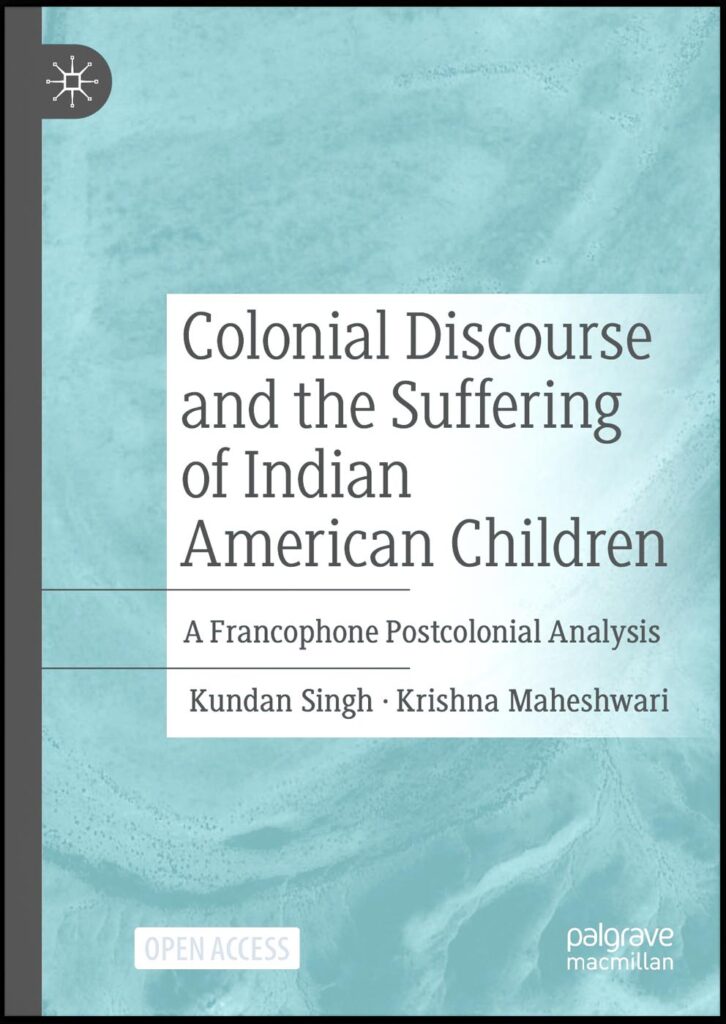Explore the origins of what American schools continue to teach about Hinduism
By Koenraad Elst
Kundan singh’s and krishna maheshwari’s book, Colonial Discourse and the Suffering of Indian American Children, deals with a real concern of Hindu Americans: the harmful reputation created for their homeland and religion from colonial times to the present day. It inscribes itself in the worldwide task of decolonization, and specifically applies the distinctive analysis produced in the French-speaking part of the colonial world as contrasting with the better-known Anglospheric approach.
“Decolonization” has been all the rage for a while now, especially in India. Like most people in what used to be the Third World, Indians have needed some time to supplement the formal political decolonization of 1947-50 with the next stages.
During the first half-century of Independence, India could hardly take up its role as a new world power. This was due in part to its immersion in proverbial poverty, largely self-inflicted because of Jawaharlal Nehru’s and Indira Gandhi’s statist policies and the concomitant corruption. It’s one of history’s paradoxes that in many decolonized countries, the new elites were swayed less by indigenous ideologies than by Western imports like Fabian Socialism and Marxism. To be honest, the anticolonial thinkers we are about to discuss here were not free from this tendency either.
This stagnation reflected on the image of Indians in the diaspora. The first Indo-American children were frequently confronted with stereotypes of Indian poverty, of “lepers dying in the gutters of Kolkata” who, if lucky, were picked up “by our Mother Teresa.”
The decisive course correction came in 1991, with the liberalization by Narasimha Rao. The onset of visible economic emancipation coincided rather precisely with the millennium: since then, PMs Atal Behari Vajpayee, Manmohan Singh and Narendra Modi have successfully pursued policies of growth. India started catching up with its daughter communities abroad that had already established a name for competence and entrepreneurial success. Any regular visitor has witnessed how India has become less poor, less chaotic, more efficient and cleaner.
So far, so good. This more prosperous and dynamic atmosphere creates the right condition for the final stage: cultural decolonization. The last decades have seen the emergence of independent pro-Hindu platforms through Internet channels. These have taken up cultural decolonization, first as little more than a slogan, but increasingly as a real program. The BJP government since 2014 initially showed no interest in this cultural dimension, apart from the symbolic gesture of some changes of Moghul or British names of towns or streets to indigenous ones. But at last it has started promoting the exposure to and study of “Indian Knowledge Systems.” Pioneered by professors Kapil Kapoor and Michel Danino, these focus on India’s ancient contributions to science and social progress and their promise for future development. Hinduism’s self-image is at last taken up as a subject of concern.
Meanwhile in the West, and surprisingly even in the USA, as the multicultural country par excellence, the colonial-age stereotyping of India and Hinduism proves remarkably resilient. Hindu organizations have to wage a struggle for every inch of correction to the picture of Hinduism painted in school textbooks, movies or publicity.
Oppression and James Mill
The starkest instance of colonial stereotyping, thoroughly analyzed in this book, was James Mill’s book The History of British India (1840). In the introduction, he is described as having “devoted considerable space to arguing that Hinduism was a primitive and Pagan religion” that was “irrational, superstitious, incoherent and child-like.” Hindu pupils in the American school system are taught about their own religion in a format almost literally taken from Mill’s book, as Singh and Maheshwari illustrate with examples from the California Board of Eduction’s official history curriculum and an approved textbook.
This sums up the image problem that Hindus as such are still confronted with, though the language is now often sanitized to comply with multiculturalist guidelines. It is a case of “epistemic violence,” in which the colonizer cemented his oppression through his discourse about the colonized which then became the “accepted truth.” Christian and secular Americans have inherited and embraced it, and the otherwise over-used term “oppression” still applies in this respect to America’s “wealthiest immigrant community”—Indian Americans. The configuration of forces has changed since Mill’s day, but two factors have remained. The first, which actually predated him, galvanized by the new opportunities created by colonization: missionary Christianity. Much less important today, the US is the main country where it still makes a difference. Ancient Christian objections to “idolatry” are still hurled at Hindu-American kids today.
The second factor that has functioned all through till today, and was somewhat surprisingly emphasized by Mill—a scion of Britain’s class society—is egalitarianism. During this period, the British Navy was intercepting slave ships, and the Empire was nudging or forcing other countries, including what remained of the Moghul Empire, to abolish slavery.
The narrative on Hinduism “revolves around hierarchy and oppression,” state the authors in the introduction. So, mind you, instances of oppression between natives serve as arguments justifying colonial oppression. Many indictments of Hinduism as oppressive were cited by Mill and by numerous anti-Hindu polemicists since then, also by modern missionaries. Among ignorant Westerners, the wider background to the popularity of Hinduphobia today is the vague knowledge of Hindu inegalitarianism, particularly caste. In America, the nation that fought a terrible civil war over the abolition of racial slavery, there is a basic disapproval of a caste inequality, which is perceived as another form of racial slavery. This perspective has been applied to India via the Aryan Invasion Theory. To sum up, the authors show that the language of egalitarianism versus oppression has been instrumentalized into a bludgeon against Hinduism.
Francophone Critique
To this problem, Kundan Singh and Krishna Maheshwari bring to bear the analyses of three Francophone authors who lived through the political decolonization: Aimé Césaire from Martinique, a local politician (Discourse on Colonialism); Frantz Fanon, also from Martinique, a psychiatrist (The Wretched of the Earth and especially Black Skins, White Masks); and Albert Memmi from Tunisia, novelist and literature professor (The Colonizer and the Colonized). Most active in the 1950s, they were fairly influential in the European Left and were promoted by leading intellectuals like Jean-Paul Sartre. In the Anglosphere, at least, their books did get translated over the years; but the present book will certainly make a difference in highlighting their message.
At that time, French was still a close second to English as a medium for intellectual discourse, pioneer of ideological fashions like Structuralism and Existentialism. It was the language of the second (to Britain) Colonial Empire, which experienced a more dramatic disintegration. Since at least the difference between England’s “Glorious, Bloodless Revolution” (1688) which transferred power to the people from the king and France’s more violent revolution in 1789, the English have been better at dressing up their political dramas, like the Gandhi-colored “Transfer of Power” in India vs. the intense Decolonization War in Vietnam and Algeria. So French-language intellectuals can be counted on to give the raw version.
Singh and Maheswari begin by citing Fanon and Memmi as pointing out that “every European imperial power engaged in the construction of the colonized in every country as barbarian and uncivilized,” and that the “complicit intellectuals” developing this discourse thus “provided the rationale for the continued colonization.” In the European imagination, India had always been looked up to and remained a fascinating wonderland until the onset of colonization, when it lost much of its shine very swiftly.
An insight from this school, which gradually became accepted wisdom, is that Fascism and Nazism were forms of “colonialism and racism turned inwards.” Hitler himself took the Britons in India as model of his own plans in a conquered Russian living-space. Conversely, one can deduce that colonialism itself was the more exotic sister of Fascism, making the recent trend of an apologetics of colonialism by Conservatives more difficult.
Racism
According to both the considered authors and those of the present book, “this misrepresentation is essentially racist.” Similar phrases echo throughout the book. As an account of the message and influence of a few thinkers, no fault can be found with it, but around the term “racism” a major problem arises that most who support this analysis seem not to realize.
A discourse that the authors characterize as “colonialist and racist” is, according to them, “still alive and kicking.” Yes, the anti-Hindu discourse is very alive, but is it still racist? It must be, if we are to believe the numerous Hindus who have been giving their opinion on trendy Hinduphobia as “racism.”
Yes, there is a clear continuity in the discourse on Hindus from the colonial age till today; and yes, racism was a motive behind it—back then. But here it takes a leap to project the racism situation in the days of James Mill or even Frantz Fanon onto today’s post-Obama America. Is present-day “Hinduphobia,” in itself an undeniable phenomenon, really due to “racism”?
For decades now the New York Times has been working to make and keep its editorial board racially proportionate to the general population; yet it has not become appreciably more pro-Hindu. The NYT correspondent spinning news in an anti-Hindu sense today may well be Black or Hispanic, or indeed South-Asian. The paper is militantly anti-racist, but that doesn’t make it less anti-Hindu.
Think of it: like whites in the US, Hindus in India are the (dwindling) majority to be figuratively shot down. They too, as inheritors of the Aryan Invaders, oppress the indigenous population. Their caste system, according to the Hindu-haters, is a racial Apartheid system: if we were right in destroying South-Africa’s Apartheid, shouldn’t we also eliminate casteism and its underlying motive, Hinduism?
When you explore the real hotbeds of anti-Hindu agitation, like the “Dismantling Hindutva” conference or the initiatives to divide American Hindus by caste, you might perhaps find a white crypto-racist as supporter, but the starring role is invariably for so-called South-Asians, mostly born Hindus. It’s not for racial reasons that those people hate Hinduism.
A factor of Hinduphobic discourse, which many Hindus polemically put down as “racist,” was and still is missionary Christianity. This was then and remains today a motive for slandering Hinduism. But Hindus are setting themselves up for defeat if they mis-characterize this as “racism.”
In the Roman empire, the missionaries converted fellow Mediterranean types, using all the tricks that their (increasingly native) colleagues use in India today. When Ethiopia got converted in the 4th century, it at once started depicting Jesus as Black. If Europeans likewise started depicting him as European, it was fully correct, not because Christianity is white racist, but because it targets all mankind: its Son-of-God doctrine means that “God has become one of us.” If Ethiopians or North Europeans depict Him as one of their own, it is historically imprecise but theologically fully correct. Religion is not race. You can frame the Hinduphobia problem in racial terms and feel great surfing the Woke Zeitgeist, but you’ll be intellectually lazy, and more consequentially, you’ll be wrong.
So in conclusion: as an exercise in erudition, exploring relevant yet new ground, this is a great book. It is very informative on anti-Hindu propaganda in history and today. But as a help to the Hindu cause in America today, it risks encouraging many readers in an already extant anachronistic reading of their situation. Rather than due to racism, the Hinduphobia they face is due to 1) the import from India of petty political quarrels playing out over there, to 2) a lingering Christian fanaticism, and today especially to 3) a heightened egalitarianism poorly informed about historical and present-day Hindu society.
DOWNLOAD THE BOOK HERE: https://bit.ly/ColDiscourse
About the Author

Koenraad Elst holds a PhD in Oriental Philology & History (Leuven University) and has authored many books on aspects of India’s religious politics, among them Decolonizing the Hindu Mind.
